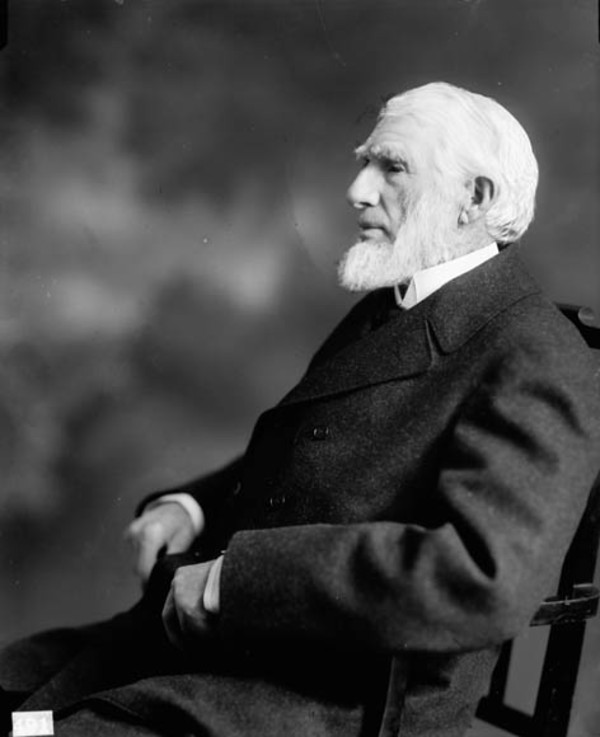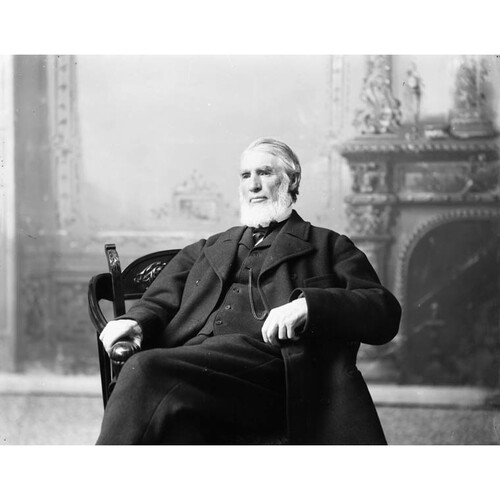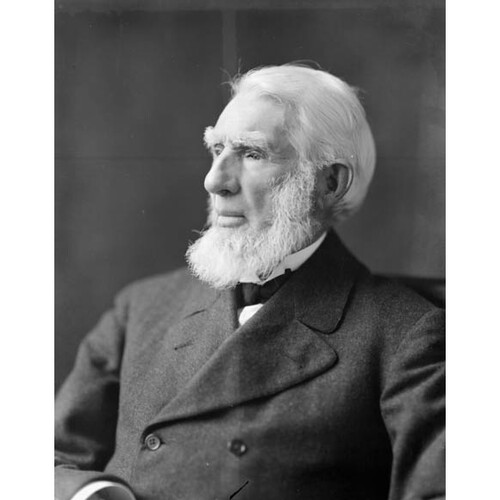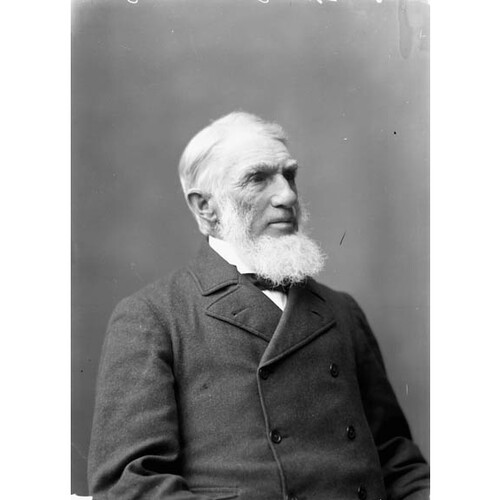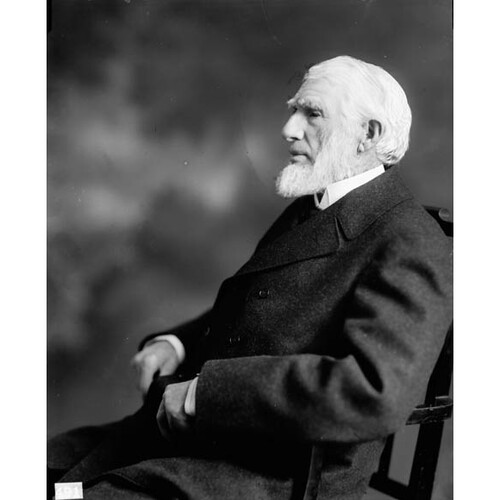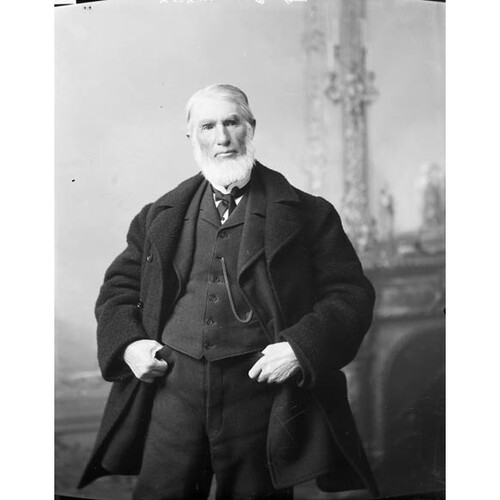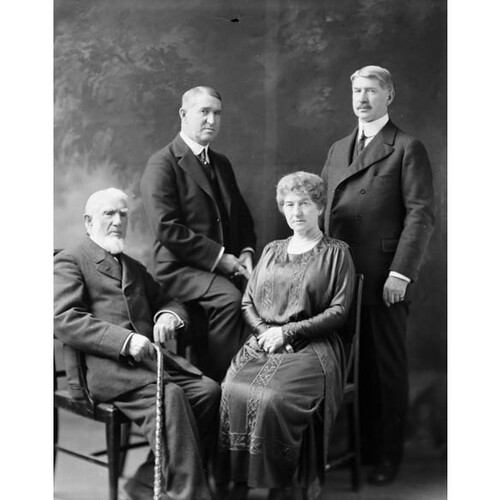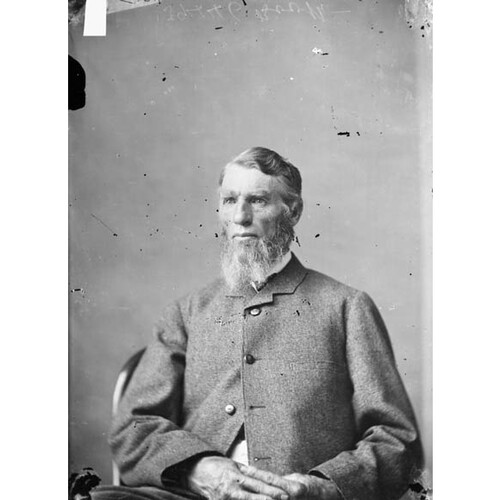BOOTH, JOHN RUDOLPHUS, industrialist; b. 5 April 1827 near Waterloo, Lower Canada, son of John Booth and Eleanor Rooney (Rowley); m. 7 Jan. 1853 Rosalinda Cooke (d. 1886) in Kingsey township, Lower Canada, and they had five daughters and three sons; d. 8 Dec. 1925 in Ottawa.
The second eldest of the five children of an Ulsterman and his wife, John R. Booth was born in the Eastern Townships. Historian William E. Greening reports that as a child he “spent his spare time building miniature mills and bridges along the tiny rivulet that flowed through his father’s farm.” Whatever his early interests, it was with a modest elementary education that he left home as a youth. He contemplated joining the California gold rush before finding employment with the Central Vermont Railroad, chiefly as a carpenter on bridge projects. He also had some involvement in the construction of a paper mill in Sherbrooke, Lower Canada, and a sawmill near Hull. Upon completion of the latter, its owner, Andrew Leamy, engaged him to manage the operation for a year. He then ran a shingle mill in premises in Hull rented from Alonzo Wright*, but within months it was destroyed by fire.
Around 1854 Booth and his wife had moved across the river to Ottawa, where J. R., as he became known, furthered his understanding of the lumber trade and water-power. Having leased Philip Thompson’s large sawmill on Chaudière Island, between Hull and Ottawa, which was selected in 1857 as Canada’s capital, he tendered successfully in 1859 for a contract to supply lumber and timber for the new Parliament Buildings [see Thomas McGreevy*]. In harvesting timber for this project, he is credited with introducing horses to replace oxen in skidding logs to water. (The acreage he acquired southwest of Ottawa for pasturing his horses would later become the Dominion Experimental Farm.)
The financial success of the contract, and of a short-lived partnership with American lumberman Albert W. Soper, allowed Booth in 1864 to purchase the Thompson mill and the adjoining mill-lots of Lyman Perkins. More significant, his reputation for reliable performance facilitated his access to additional capital. In 1867, with the backing of the Bank of British North America and on the advice of his cousin Robert R. Booth of Pembroke, he bought the valuable pineries on the Madawaska River previously owned by John Egan*. Following this acquisition, which he later described as the basis of his fortune, he joined the effort to construct works to facilitate timber drives, as a founder of the Upper Ottawa Improvement Company, formed in 1868 to build dams, slides, and piers; in 1888 he would become the founding president of the Madawaska Improvement Company Limited. In addition to steadily expanding his milling and driving operations, he had established docks and a lumber storage and distribution centre in 1868 at Rouses Point, N.Y., a planing mill and box factory in 1875 in Burlington, Vt, and a sales office in 1877 in Boston. With these facilities he was said to be “the only Canadian lumberman at the time who manufactured his own lumber in his own American mill.”
During the economic downturn of 1874–76 Booth had continued to accumulate timber limits at low prices, thus eliminating his dependence on other suppliers. Eventually covering 640,000 acres, his limits extended throughout the Ottawa watershed, encompassing parts of the Madawaska, Bonnechere, Petawawa, Mattawa, and Montreal rivers in Ontario and the Coulonge, Black (Noire), Dumoine, and Kipawa rivers in Quebec. Montreal lumber merchant and biographer George Arthur Grier has claimed that Booth, an incessant traveller throughout his domain, “knew the forest as a sailor knows the sea, and his success was largely due to the fact that he never overestimated its potentialities.” Between 1872 and 1892 his manufacture of lumber increased from approximately 30 million board feet to 140 million, an expansion that made his operations the largest in the world. Booth’s output of 115 million feet in 1896 was more than double that of any other major Ottawa valley firm, including McLachlin Brothers of Arnprior [see Daniel McLachlin*] and Bronsons and Weston of Ottawa [see Henry Franklin Bronson*]; by 1900 all of the coastal mills in British Columbia [see John Hendry*] were producing only 100 million feet annually.
As a natural extension of milling, Booth’s operations had grown to include a far-reaching transportation network. His involvement with forming and financing the Canada Atlantic Railway in 1879 [see Donald Alexander Macdonald* (Sandfield); William Goodhue Perley*] had drawn him into construction when the original proponents were unable to complete the project. He embraced this new phase of his career with enthusiasm. Railways offered his lumber business three major advantages: reduced labour costs on timber drives, freedom from the seasonal constraints on shipping, and speed. In 1882 Booth completed the 136-mile linkage of the CAR between Ottawa and Coteau-Landing on the St Lawrence, from which point the line eventually secured access to the Central Vermont; initially, the crossing had to be done by barge, but in 1890 this interruption was eliminated by the opening of a railway bridge across the river. To link the pinelands of Georgian Bay, his own upper limits, and the Ottawa River, Booth had started in 1884–86 with a small railway connecting lakes Nipissing and Nosbonsing. Next, the Ottawa, Arnprior and Renfrew and Ottawa and Parry Sound railways were chartered in 1888 and amalgamated in 1891 as the Ottawa, Arnprior and Parry Sound Railway, which was built in 1892–96. During construction, in 1893 Booth successfully disputed the rights to a strategically important pass near Wilno, which the rival Canadian Pacific had also claimed, and he sought to influence the southern boundary of the newly created Algonquin Park [see Aubrey White*] to avoid conflict with his line. (In the end, it ran through the park and Booth secured limits there.) Apart from the advantage the OAPS offered Booth in the lumber trade, for others the route cut 800 miles off the journey from Chicago to Montreal, with mile-a-minute service along the Ottawa–Montreal segment. To secure even more traffic, especially grain, Booth established elevators at Depot Harbour near Parry Sound, as well as at Duluth, Milwaukee, and Coteau-Landing. He eventually added a small fleet of ships to what was recognized as the largest privately owned railway in the world. The OAPS was merged in 1899 into the Canada Atlantic, and in 1904 Booth sold it for $14 million to the Grand Trunk, which he served as a director until it became part of the Canadian National system.
The empire of J. R. Booth was constantly susceptible to devastation by fire, in the bush, on his railways, and at the Chaudière. His mills were severely damaged in 1893 and again in 1894, when, not surprisingly, he needed 20 British, 5 American, and 3 Canadian firms to underwrite his insurance. In 1895 his Burlington facility was gutted. The disastrous fire of 1900 that cut through Hull and Ottawa caused Booth losses estimated at between one and one and a half million dollars. A major fire in 1903 consumed 10 million feet of lumber, 8 railway cars, and numerous buildings and nearby homes. On the occasion of a conflagration at his mill in September 1913, the second in a week, his son and superintendent, Charles Jackson, discounted the likelihood of arson: the fire, he told the Ottawa Evening Journal, appeared “to be just one of those things which visit such plants periodically.” The risk had become such a concern to Ottawa’s residents and city council, however, that there was considerable resistance in 1917 to J. R. Booth’s use of a river-lot at the end of Bronson Avenue for storage. It was the government’s need for the property to house a new heating plant for the Parliament Buildings that pushed Booth’s mountains of lumber out of Ottawa.
With vast timber resources at his disposal, Booth’s concepts of conservation were largely defined in terms of controlling bush fires, which he usually blamed on settlers and prospectors. At the same time his mills attracted attention as concern mounted over the effect of sawdust, trimmings, and other waste on navigation and fisheries. Following the passage of federal legislation in 1873 that prohibited dumping in water, Booth was convicted and fined. Despite a vigorous legal campaign begun against him and other owners in 1885 by Antoine Ratté, an Ottawa wharfinger and boatbuilder whose business suffered from mill refuse, Booth declined to alter his practices until early in the 20th century. He complied, it appears, only because a fire that destroyed much of his plant provided an opportunity to introduce new procedures to eliminate dumping directly into the water.
Beginning in the 1850s, the periodic public examinations of the crown’s water rights and works at the Chaudière, including Albert and Victoria islands, had become matters of consequence to the industrial complexes concentrated there. Crown reviews led to legal adjustments to Booth’s ownership in 1889 and 1901. His interests stood to be affected too by Quebec’s grant to private hands of 31 acres of river-bed, which figured prominently in the complex legal preparations begun in 1900 by Æmilius Irving* and others for a reference to the Supreme Court of Canada over jurisdiction and the exact location of the Ontario-Quebec boundary. In February 1903 a perplexed Ottawa Citizen asked “Who owns the river?” The matter was no clearer in 1905 when Ezra Butler Eddy* of Hull took Booth to court over water diversion.
As the traditional lumber trade approached its zenith – the final raft of squared timber would be taken down the Ottawa by Booth’s men in 1908 – Booth embarked upon a number of new ventures. Following a fire at McKay Milling at the Chaudière, he purchased the site for pulp production, a sector pioneered by Eddy. Constructed in 1905, the new plant let him make more effective use of the large quantities of softwood he had previously been forced to sell. Also in 1905, his winning bid for the 1,700-square-mile concession of the Montreal River Pulp Company allowed him the convenience of cutting both pulpwood and pine in the same limits. With 26 grinders, the ground-wood section of Booth’s mill was capable of a daily production of 182 tons; four digesters provided 30 more of sulphite pulp. Upon encountering difficulties in disposing of his pulp, Booth entered the papermaking business with a mill that put out some 150 tons of newsprint daily. Other new undertakings were purely speculative. In association with Michael John O’Brien*, for instance, Booth used the Dominion Nickel-Copper Company to consolidate mineral properties in the Sudbury area. These holdings, which the principals never intended to develop, would be sold in 1915 to the British America Nickel Corporation, a syndicate organized by Frederick Stark Pearson*. Booth’s ventureship was also evident in his board positions, including directorships in Foster-Cobalt Mining (1907) and Canada Cement (1909).
By all accounts Booth, a short man with a white beard and unfading physical vitality, was a picturesque figure, though his rough language, disdain for publicity, and plain dress put him, according to Sandra Gwyn, “decidedly beyond the pale” in Ottawa society. Still, his commercial stature commanded attention. Even late in life, he was renowned for his memory, his detailed knowledge of plant operations, and his direct participation in virtually every aspect of his firm, an involvement that periodically led to injury. There are any number of stories about visitors who eventually located him in his lumber yards or at building sites. One typical legend credits him with identifying a new horse on the day of its arrival at his mill, despite the fact that about 500 horses worked in his yards and woods. Not until 1921, during a trade slump and when Booth was 93, did he convert his operation from a sole proprietorship to John R. Booth Limited.
His managerial style was captured by Charles Christopher Jenkins in Maclean’s (Toronto) in 1922: “So far as one can learn, John R. Booth has never encouraged initiative or originality in those he has hired as executives, a failing which seemingly has not debarred him from becoming one of the wealthiest and mightiest masters of industry in Canada.” More recently, archivist Neil Forsyth has portrayed Booth as “autocratic in the extreme; employees did what they were told or departed.” In testimony to the royal commission on the relations of labour and capital in 1889, Booth frankly professed no knowledge of regulations under the Ontario Factories’ Act. Writer Doris French has characterized his association with labour as “old-fashioned and feudal”; no model employer, J. R. knew that his workforce was transient, seasonal, and traditionally resistant to organization. He was a leading figure in opposing a general strike that affected his Burlington mill. In 1891 Booth and eight other owners were hit with a massive, prolonged strike by Chaudière millworkers over subsistence wages and 11- or 12-hour days, an action eventually led by the Knights of Labor. The call-up of police and the militia probably had Booth’s approval if not his active encouragement. In a strike in 1918 unionized paper-mill workers in Ottawa demanded increased wages from Booth or a public investigation, but he flatly refused any concession; they struck again in 1921.
There were, of course, paternalistic exceptions in Booth’s treatment of labour. During a strike at the Grand Trunk that shut down his mills in July 1910 and put 2,000 men out of work, he paid his employees full wages for their lost time. In the somewhat misleading words of the Citizen, “By one of the most generous acts in a long career of charitable deeds and looking after the best interests of his many employees, Mr. Booth had again shown the men that he was one of them.” He has also been credited with introducing the eight-hour day to the forest industries of the Ottawa valley in 1911 on his own initiative.
Although there is some indication that Prime Minister Sir Charles Tupper* may have attempted to recruit him as a Conservative candidate in May 1896, Booth was by no means prominent politically. He usually devoted such time as he cared to allocate to public affairs to matters directly related to his industrial concerns. As a papermaker, for example, he joined ranks with Charles Christopher (Carl) Riordon, E. B. Eddy, and others to campaign for prohibitions on the export of unmanufactured pulpwood to the United States, and he successfully lobbied for cutting rights to birch in Algonquin Park. Only in opposition to Sir Wilfrid Laurier*’s advocacy of reciprocity in the federal contest of 1911 did he appear to take an active role in the electoral process.
In Ottawa, Booth, a Presbyterian, quietly made substantial financial contributions to community projects, including the Young Men’s Christian Association building and St Luke’s Hospital [see Annie Amelia Chesley*], which he helped found in 1897 and endowed in 1914 with a new wing. Described as “a believer in and a generous patron of clean, manly sport,” he was a member of the Ottawa Amateur Athletic Club and the Ottawa Rowing Club. In 1903 he was named honorary president of the Canadian Reading Camps Association, which distributed literature to and promoted night schools in lumber and mining camps. At the time of World War I, he made the largest donation to purchase equipment for the No.1 Automobile Machine-Gun Brigade.
By the time he was in his nineties, Booth had achieved a reputation of legendary proportions tinged with the romance of the northern woods, even though by 1919 his production was being eclipsed by W. C. Edwards and Company Limited and others. On 27 March 1920, in a rare public appearance and to a “rousing ovation,” Booth dropped the puck for a Stanley Cup match between the Ottawa Senators and the Seattle Metropolitans. Within the timber industry he received plaudits as honorary president of the Canadian Lumbermen’s Association. Booth’s achievements inspired C. C. Jenkins to describe him in 1922 as one of those “men who have transformed the dreamy melody of the living waters into a roaring chant of commercial conquest.” In the words of Michael Grattan O’Leary* in the Evening Journal in 1925, the Booth to remember was “not the great magnate whose wealth is the envy of many and the wonder of more; but the great pioneer, the man whose genius and imagination tamed the wilderness . . . and, above all, did more than any man of his time to build up this Ottawa Valley.” On the occasion of his death in December 1925, following two months of confinement at his Ottawa residence, Prime Minister William Lyon Mackenzie King* generously referred to him as “one of the fathers of Canada.” Buried beside his wife in Beechwood Cemetery in Ottawa, Booth was survived by his sons Jackson and John Frederick and his daughter Helen Gertrude Fleck.
Booth’s fortune was a subject of much speculative commentary during the latter years of his life, with estimates ranging up to $100 million. At the time of the marriage in 1924 of his granddaughter Lois Frances Booth to Prince Erik Christian Frederik Alexander of Denmark, it was rumoured that Booth contributed half of her $4-million dowry. J. R. issued a formal denial. At his death his estate was officially valued at almost $7.7 million; the property was later re-evaluated upwards. Although succession duties exceeding $4 million were paid in 1927, Ontario Premier Mitchell Frederick Hepburn* subsequently claimed more and invoked the legislature to overcome the legal obstacles. The heirs eventually paid another $3 million.
Contemporaries often referred to J. R. Booth as a lumber king, the equivalent perhaps of today’s media moguls. Booth understood the regional economy of the Ottawa valley and its relationship to international trade as well as or better than any of his peers. Through hard work, resolute determination, and longevity he contributed greatly to the private economy of the government town that Ottawa had become.
Virtually no papers have survived for J. R. Booth personally or for the Booth company.
ANQ-E, CE502-S42, 7 janv. 1853. AO, F 137; F 1027, package 50; RG 22-354, no.12659; RG 80-8-0-108, no.2379; RG 80-8-0-988, no.10201. NA, RG 31, C1, 1871, Ottawa, Victoria Ward, div.2: 119. Ottawa Land Registry Office, Abstract index to deeds, Chaudiere lots (mfm. at AO). Globe, 9 Dec. 1925. Ottawa Citizen, 27 June 1894, 27 April 1900, 19–28 July 1910, 29 March 1920. Ottawa Evening Journal, 21 April 1893, 4 Aug. 1910, 8 Sept. 1913, 17 Aug. 1917, 13 June 1925. Ottawa Free Press, 27 May 1886. Canada Lumberman (Toronto), 41 (1921). Canadian annual rev., 1907–20. C. F. Coons, “The John R. Booth story,” Your Forests (Toronto), 11 (1978), no.2: 8–26. Encyclopaedia of Canadian biography . . . (3v., Montreal and Toronto, 1904–7), 2: 2. Neil Forsyth, “J. R. Booth: career of a lumber baron,” Archivist (Ottawa), 14 (1987), no.5: 10–11. Doris French, “The Booths of Ottawa,” Chatelaine (Toronto), 36 (1963), no.12: 22–23, 65–68, 71–75. Peter Gillis, “Rivers of sawdust: the battle over industrial pollution in Canada, 1865–1903,” Journal of Canadian Studies (Peterborough, Ont.), 21 (1986–87): 84–103. W. E. Greening, The Ottawa ([Toronto], 1961). B. W. Hodgins and Jamie Benidickson, The Temagami experience: recreation, resources, and aboriginal rights in the northern Ontario wilderness (Toronto, 1989). J. W. Hughson and C. C. J. Bond, Hurling down the pine the story of the Wright, Gilmour and Hughson families, timber and lumber manufacturers for the Hull and Ottawa region and on the Gatineau River, 1800–1920 (2nd ed., Old Chelsea, Que., 1965). C. C. Jenkins, “J. R. Booth – on the job at 95,” Maclean’s (Toronto), 35 (1922), no.10: 15–16, 61–62. G. S. Kealey and B. D. Palmer, Dreaming of what might be: the Knights of Labor in Ontario, 1880–1900 (Toronto, 1987). Labour Gazette (Ottawa), 18 (1918): 917. R. S. Lambert with Paul Pross, Renewing nature’s wealth: a centennial history of the public management of lands, forests & wildlife in Ontario, 1763–1967 ([Toronto], 1967). A. R. M. Lower, Great Britain’s woodyard: British America and the timber trade, 1763–1867 (Montreal and London, 1973). J. S. P. McLaren, “The tribulations of Antoine Ratté: a case study of the environmental regulation of the Canadian lumbering industry in the nineteenth century,” Univ. of New Brunswick Law Journal (Fredericton), 33 (1984): 203–59. H. V. Nelles, The politics of development: forests, mines & hydro-electric power in Ontario, 1849–1941 (Toronto, 1974). Standard dict. of Canadian biog. (Roberts and Tunnell), vol.1. J. R. Trinnell, J. R. Booth: the life and times of an Ottawa lumberking (Ottawa, 1998).
Cite This Article
Jamie Benidickson, “BOOTH, JOHN RUDOLPHUS,” in Dictionary of Canadian Biography, vol. 15, University of Toronto/Université Laval, 2003–, accessed December 30, 2025, https://www.biographi.ca/en/bio/booth_john_rudolphus_15E.html.
The citation above shows the format for footnotes and endnotes according to the Chicago manual of style (16th edition). Information to be used in other citation formats:
| Permalink: | https://www.biographi.ca/en/bio/booth_john_rudolphus_15E.html |
| Author of Article: | Jamie Benidickson |
| Title of Article: | BOOTH, JOHN RUDOLPHUS |
| Publication Name: | Dictionary of Canadian Biography, vol. 15 |
| Publisher: | University of Toronto/Université Laval |
| Year of publication: | 2005 |
| Year of revision: | 2005 |
| Access Date: | December 30, 2025 |


